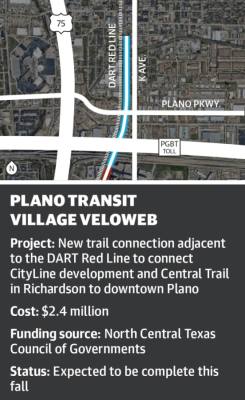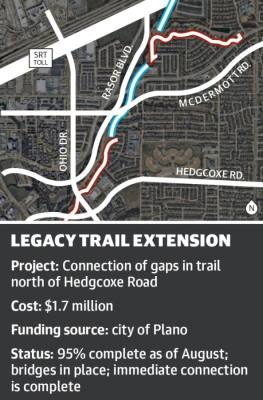From her home, a little more than 200 yards from the trailhead, Barbaro has seen a lot more traffic in recent months on Legacy Trail, which runs along White Rock Creek in northern Plano. With the addition of bridges over the creek and paths from nearby neighborhoods to the trail, it’s now that much easier for her to start her runs, she said.
Legacy Trail has undergone two expansions over the past two years. The first, a $3.3 million project, connected a gap in Legacy Trail south of Legacy Drive and was completed this spring. A second roughly $1.7 million project north of Hedgcoxe Road is close to completion, with much of it already open to visitors.
Recently completed expansions along the Windhaven Meadows Park Trail, which runs along Spring Creek Parkway, make it possible to travel along connector trails, such as the Legacy Trail, all the way to Preston Ridge Trail, which runs parallel to Coit Road through Plano, the city’s Parks and Recreation trail system planner Lance Knox said.
The Plano Running Club takes advantage of the flexibility these connections give for running different distances, Barbaro said. The club often starts its runs in Windhaven Meadows Park because of its access to other trails.
Pushing for connectivity
Trails like the Cottonwood Creek Greenbelt, an eastern trail that was expanded to the north in late 2019 to connect with Allen, are among those highlighted in the 2001 Six Cities Trail Plan between Richardson, Garland, Plano, McKinney, Frisco and Allen. This plan sought to create a main trail spine that connects the six cities, according to Richardson parks staff.
Legacy Trail has since been recognized as a regional trail connection by the plan, Knox said, meaning that it has the potential to help fill regional gaps in trails.
As trails spread closer to the edges of the city, the next natural step is to connect them with trails in neighboring cities, Knox said. An example of this is the Preston Ridge Trail, which ends near Frisco at Ridgeview Drive. Residents have already shown an interest in a connection there, although there are no concrete plans for that project as of now, he said.
In order to keep creating these connections, cities often work together or with other government agencies to secure funding, Knox said.
In the case of the upcoming Silver Line Rail Trail, a $3.4 million project also known as the Cotton Belt Trail, half of the funding comes from the Texas Department of Transportation, and Plano is paying for the remaining portion within city limits. This project will be built in tandem with the Silver Line Rail, with completion expected in the early 2020s.
Funding to expand Preston Ridge Trail to Dallas’ city limits largely depends on receiving a grant from Collin County, Knox said. The city of Plano expects to start slowly filling the roughly two-mile gap in the trail beginning in 2021. The first phase of work is expected to cost roughly $550,000.
Making recreation safer
The Legacy Trail expansion and other trail projects help keep trail users from having to worry about dangerous intersections, Knox said.
Large runs have been paused due to the pandemic, but even in smaller groups where skill levels are mixed, the Plano Running Club finds trails to be the safest option to avoid dangerous traffic, Barbaro said.
For some bicyclists, busy roads in Plano are preferred over trails, according to Michael Gacki, ride coordinator with the Plano Bicycle Association. Because of how popular Plano’s trails are, bicyclists riding at 25 mph can cause collisions with people moving at lower speeds, he said.
Instead, Gacki said he is hopeful that Plano will consider adding bike lanes to major thoroughfares, such as Independence Parkway and Coit.
As ongoing projects come to a close, the city remains open to feedback about which trails the city should tackle next, Knox said.









